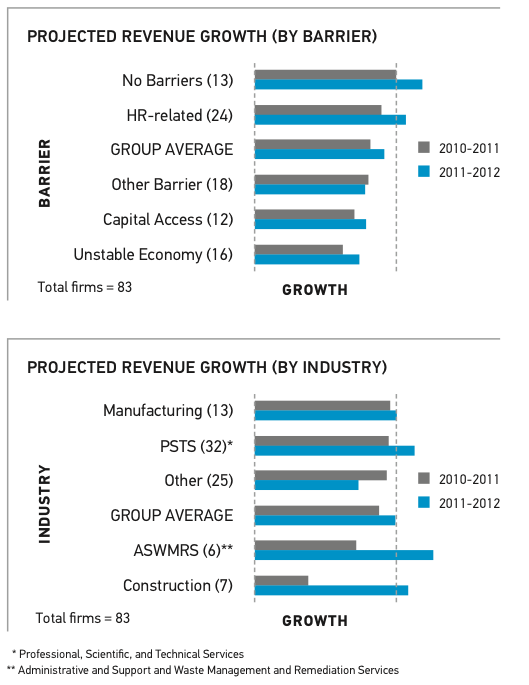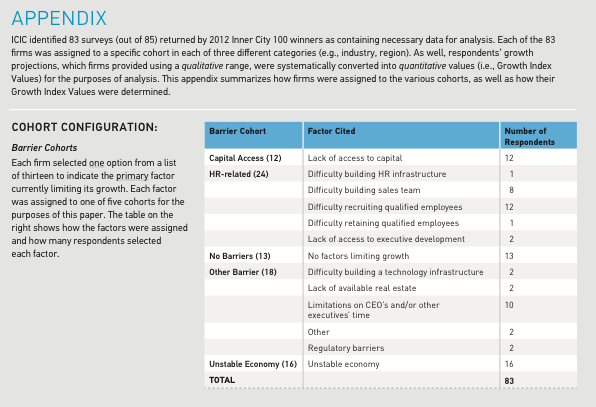INITIATIVE FOR COMPETITIVE INNER CITY
The Disparate Challenges To Growth
 Do hyper-achieving, fast-growing companies have any limits to growth? That was a question ICIC staff hoped to answer as they scrutinized surveys returned by 2012 Inner City 100 winners this past winter. After all, the average winner had seen its revenue increase at a 40% compound annual growth rate (CAGR) between 2006 and 2010 – the Great Recession notwithstanding. Were winners susceptible to economic gravity?
Do hyper-achieving, fast-growing companies have any limits to growth? That was a question ICIC staff hoped to answer as they scrutinized surveys returned by 2012 Inner City 100 winners this past winter. After all, the average winner had seen its revenue increase at a 40% compound annual growth rate (CAGR) between 2006 and 2010 – the Great Recession notwithstanding. Were winners susceptible to economic gravity?
As it turns out, survey respondents revealed that not even super achievers are necessarily immune to growth challenges. The firms’ self-reported revenue growth projections for the periods 2010-2011 and 2011-2012 revealed a surprisingly varied picture.
In the previous paper in this series we noted that a lack of growth capital can be a major impediment to a firm’s growth. Survey results underscored that point. When firms were asked to assess their revenue growth prospects for the period 2010-2011, those which cited capital access as their current primary barrier to growth fell into the cohort second from the bottom in terms of revenue projections. Only firms citing an unstable economy fell into a cohort with a worse outlook for this period. Firms in these two cohorts had on average significantly lower revenue growth projections than companies citing no current barriers to growth.
Also noteworthy was that although firms citing HR-related barriers had relatively high revenue growth projections, they still lagged respondents citing no current barriers to growth. The observation recalls the importance of human capital to the success of firms. Companies citing HR constraints limiting their current growth prospects overwhelmingly cited either difficulty recruiting qualified staff or difficulty building their sales team as their specific concern.
An equally striking variation in firms’ revenue growth projections was apparent when ICIC looked at them through the lens of industry cohort. Firms in the construction industry, for example, had by far the lowest projected revenue growth for the period 2010-2011. This was unsurprising given the severe downturn the construction industry as a whole has experienced the past few years with the bursting of the housing bubble. On a positive note, though, construction had a far more optimistic perspective on revenue growth for the period 2011-2012.
Read full report (PDF) here: The Disparate Challenges To Growth
About The Initiative for a Competitive Inner City (ICIC)
www.icic.org
“The Initiative for a Competitive Inner City is a nonprofit research and strategy organization and the leading authority on U.S. inner city economies and the businesses that thrive there. Founded in 1994 by Harvard Business School Professor Michael Porter, ICIC strengthens inner city economies by providing businesses, governments and investors with the most comprehensive and actionable information in the field about urban market opportunities.”







 RSS Feed
RSS Feed